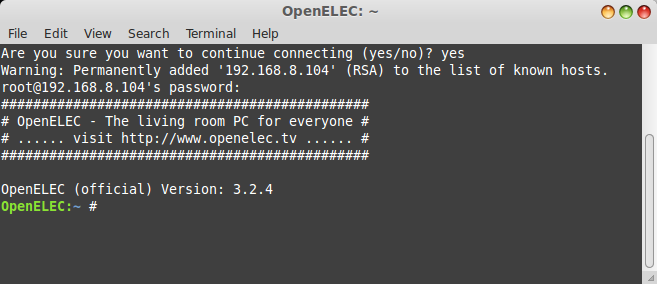
OpenElec 5.0 release works as well but doesn't have any additional benefit for the Hyperion setup. OpenElec 4.2 is the preferred Raspberry Pi distro for this guide.
#MOUNT AFATECH OPENELEC PC#
With all solutions there's no physical connection to your PC required as the Hyperion is either getting commands via your local network (TCP commands) and/or via video capture thru HDMI. Raspberry Pi -> USB connection to video capture stick Video capture solution WS2801 / WS2812 with Raspberry Pi and Arduino

LED power pins -> 5v adapter -> only GND connected to Arduino as well (see tutorial) Non-video capture solution WS2801 / WS2812 with Raspberry Pi and Arduino Raspberry Pi -> network / power connection LED power pins -> 5v adapter-> only GND connected to Raspberry Pi as well (see tutorial) Non-video capture solution WS2801 with Raspberry Pi only The linked tutorials will have connection schemes as well however this will give you a general overview on how everything is connected for each solution. So if you want to use video capture just toggle it on via remote and leave it off when needing 24p playback. Make sure you get an powered HDMI->Composite converter and not the passive one that is powered by the HDMI signal ! When video capture is turned on you are limited to 50/60hz due to technical restrictions, a solution for this is to add a remote controlled power brick (KaKu for the dutch users) and put the HDMI->Composite converter in that. Some shops might not list it correctly so be careful, got mine here: That one for now is only supported on all recent versions of OpenElec, been using it for some time now and works without issues. However recommend to use a different USB Video Grabber as this is known to work better:
#MOUNT AFATECH OPENELEC HOW TO#
Recommend following this guide which describes all the components and how to use them: One sided sticky Velcro to attach leds and rails, get the good ones and apply alcohol on contact points to allows for best adhesion Rails to attach to TV, used one sided curved plastic rails to allow for adjusting the direction. Raspberry Pi B+ (other models will probably work just as fine)ĥV 7A was used to make the videos and drives 218 leds just fine. Supports Arduino (Adalight) to allow for broad use of led chips

It does require some Linux / Raspberry Pi knowledge like connecting via SSH (Putty) but other than that it's easy to understand. Hyperion also allows for video capture methods so that you can use it for every HDMI input source be it a console or set top box.ĪtmoLight now supports Hyperion as well so no video capture hardware is required for that setup as it sends your video image directly to Hyperion over network.

#MOUNT AFATECH OPENELEC WINDOWS#
Windows and Linux support is supplied by their respected plugins (AtmoLight in our case) however the Raspberry Pi can't run the Kodi plugin for it (yet) Over time there have been many Windows alternatives to Atmowin and under Linux there is Bobilight however there is now another good all in one alternative that is networked like boblight but also works with Windows/Linux and is called Hyperion.


 0 kommentar(er)
0 kommentar(er)
